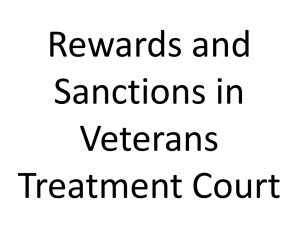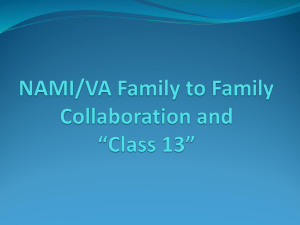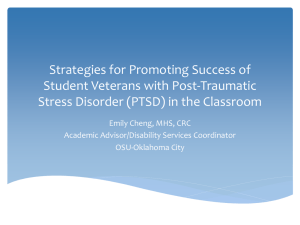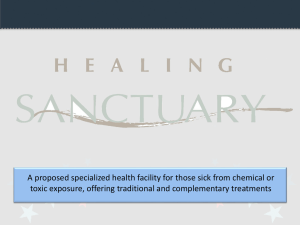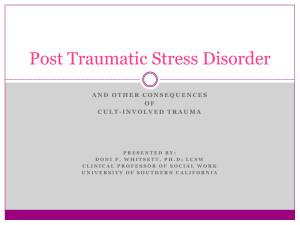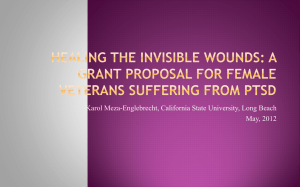Byachi
advertisement
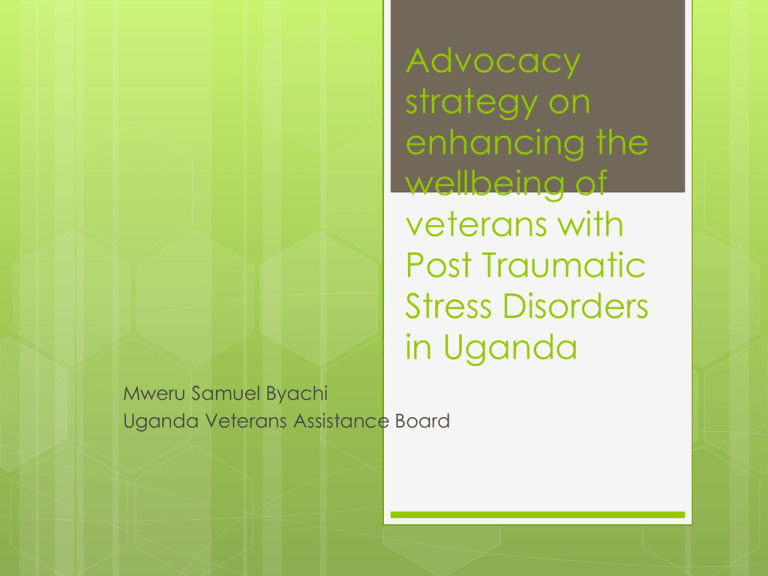
Advocacy strategy on enhancing the wellbeing of veterans with Post Traumatic Stress Disorders in Uganda Mweru Samuel Byachi Uganda Veterans Assistance Board PTSD Advocacy strategy What is PTSD? Shell shock or battle fatique syndrome A condition that can develop after one has experienced/witnessed traumatic event First brought to world attention by war veterans May begin within 3 mths but could also take years Families of PTSD victims can develop the disease PTSD cont. A global problem underestimated by LDCs In the US, 200,000 veterans received disability compensation for PTSD worth $4.3bn in 2005 11-20% of US Iraq and Afghanistan war veterans were PTSD positive About 10% of US Gulf veterans were positive Uganda estimates are about !0% of the veterans Military related causes of PTSD Exposure to combat Exposure to life threatening missions Shot at, seen a buddy shot, or seen death Military sexual trauma (sexual harassment) Other factors such as what you do in war, politics around the war, where it is fought, and type of enemy you face add more stress to an already stressful condition Effects of PTSD Victim’s loss of faith for safety, predictability or meaning in the world Haunts victim and prevents normal life Difficulty in relationships Feelings of shame, guilt, despair, helplessness, grief/loss Poor health behavior among pregnant women Memory loss among pregnant women PTSD effects cont. Babies born to PTSD mothers are likely to experience a change in at least one body chemical and later taking on the condition Failure to engage in productive life Victims risk of higher use of cigarettes, alcohol and marijuana Likelihood of committing crime PTSD treatment Treatment through psychotherapy (restoring safety feelings, calming the nervous system) Educating the victims what they are feeling Stress reducing foods also recommended Recovery involves (feeling empowered, finding meaning in life again, re-establishing a connection to oneself and feelings for other people) Why the PTSD advocacy strategy? WHO’s health definition(veterans not healthy) Uganda’s 1995 constitution provides for a right to health(yet PTSD is still a terror) Problem is big but generally faced with silence Yet it is treatable! It is worthwhile that the advocacy aimed at favorable policy change begins with me The challenges are surmountable Campaign narrative for advocacy strategy Retired Captain Moses Tabora was 10 years and illiterate when he joined the armed struggle and fought till 1995 when he left the army with one leg! Retired Sergeant Mwaka Hassan joined the rebel force when he had lost all his parents and did revenge killings whenever he could till he was discharged from the army in 1997. Retired Private Baluka Harriet was a child soldier and now has ten children each with a different father. She recently returned from Somalia as part of the Amisom troops and was diagnosed with PTSD. All these were liberators who now have become a “nuisance” through no fault of theirs. A local song composed in Uganda describes the veterans as used condoms yet they contributed a lot in ousting the dictatorship and stopped state inspired killings then. All the three have PTSD problems but government is silent. What a pity! The families of these veterans cannot afford a smile. These veterans have unexplained behavior, make noise, issue threats, utter vulgar words and cannot fend for their families. Government had put up a law to take care of the veterans but never took this problem serious. Veterans are committing crime quite often and are jailed. Nobody ever bothers to find out what the exact problem is. Families are resorting to witchdoctors for a remedy and others are going to Pentecostal churches for miracle cure. Yet this is a medical condition that can be addressed when government has the will to take it up, and mainstream it in its programs. The time is now for our legislators to own up this matter and make all interventions necessary to make the world of PTSD sufferers’ worthwhile if they are to measure up to the global standards pushed by the World Veterans Federation. It is your duty to make this change happen. Brief about UVAB UVAB is a statutory body mandated to discharge the soldiers from military service and ensure that they are sustainably reintegrated in civilian life. UVAB faces challenges of increased veterans now about one million PTSD condition not well handled Existing law has gaps that need amendment Context analysis of advocacy strategy Problem affecting about 10% of the veterans Manifestations of PTSD already explained Origin of PTSD grounded in 1981-1986 war Causes of PTSD explained Limited medical interventions made Family members, community and government most affected by problem Frequency of problem periodic or continuous PTSD impacts negatively on socio-economic and political aspects CAMPAIGN STRATEGIC FRAMERORK Objectives and key targets (SMART) To push for the amendment of the UVAB Act to include the support and treatment of the Post-Traumatic Stress Disorders (PTSD) condition among ex- soldiers by 2015 To work towards a community that has favorable perceptions of PTSD sufferers and support them by 2015 Enabling easy access of PTSD services by exsoldiers through the creation of special wings at both the regional and national psychiatric referral hospitals by 2018 Campaign strategic framework cont. Scope covers veterans countrywide and policy makers/legislators, community leaders by 2018 Critical pathways vital for each of the three objectives as road maps Various circles of influence at play for each objective remain almost the same because of the security nature of the vulnerable target M&E Framework of the strategy Objectives Desired impact Success indicators Means of verification Objective 1 A law that will take care of ex combatants with PTSD condition and improve their condition Amendment tabled and discussed Parliamentary sessions monitored Amendment passed Hansard Reports Bill assented to by H.E the President 80% of community leaders having a favorable attitude Press reports To push for the amendment of the UVAB Act by 2015 Objective 2 To work towards a community that has favorable perceptions of PTSD sufferers and support them by 2015 Objective 3 To enable easy PTSD access services through special PTSD wings in regional and national psychiatric hospitals by 2018 A civil community that fully understands the PTSD problem and be in position to sustainably address those challenges Hospitals with PTSD wings that make it easy for the ex-combatants to get quick attention regarding their conditions Community meetings 80% of PTSD veterans receiving support from the community Radio feedback 80% PTSD wings established Hospital Reports 80% Special wings operational 80% of PTSD cases reporting for treatment registered Reduced violence in PTSD homes No of veterans assisted Minutes of ministerial meetings Campaign elements Creative brief with emphasis to background to the problem hyping need for intervention Campaign objectives seek favorable attitude change and actualizing the change Messaging to policy makers and other targets focuses on need to rise to the challenge Emotions elicited seek policy change by comparison between past and present with liberators turned into rejects Campaign elements cont. Lobbying Importance of lobbying is critical in the policy process from agenda setting, option formulation and implementation My case falls at agenda setting given my targets and desired policy change Alternatives later considered Implementation would be the dream as soon as OPM communicates accordingly Policy brief document prepared aimed at giving the bigger sieved picture giving solutions and recommendations and call to action Campaign elements cont. Popular mobilization Grounds for passion for MPs done (scratch where it itches) Go for what works not strategy per se Threats of demonstration, petition to parliament and request to meet H.E the President Continuous engagement of friendly forces (via dialogue, sports, media, reminders, workshops) to keep fire burning Campaign elements cont. Media analysis Media analysis key in any campaign Done with view to getting to my objectives with cost effectiveness, efficiency, mass audiences in a timely manner Media channels identified and prioritized Relevant press releases issued with call to action Media relations should take mutually beneficial, loudspeaker, agenda setter, cordial and supportive relationships Media is supportive because of its alleged non biased nature as a fourth estate (informative, educative and entertaining roles) Alliance building (UVAB SWOT analysis) Strengths Opportunities Skilled manpower Long serving staff at headquarters Financing availed by the donor community for demobilization Created a favorable history of good performance Weekly veterans radio programs (that help in sensitization) Weaknesses Space limitations at Head Office Location on 7th Floor that is bad for Veterans with Disabilities Current limited funding Regular staff turnover in districts affecting district veterans office performance Decentralization local government policy adopted in 1997 Favorable community H.E the President is a veteran Many cabinet ministers are ex-soldiers Rt. Hon. Prime Minister is the Minister for veterans affairs Liberalization policy Vibrant civil society Threats Fight for control over veterans Limited legal mandate Instability in the region A non-supportive opposition parliament Confusion of who a veteran is Political definition of a veteran in Alliance Building cont. SWOT analysis SWOT analysis vital in the strategy to locate our standing as an organization Opportunities and risks identified help in way forward leading to a number of allies to fill gaps and enhance capacity Alliances to build in this strategy include NRM Veterans League (Ruling party organ) Uganda Local Government Association (ULGA) Uganda NGOs Forum (vibrant civil society) Uganda Medical Association Action Plan For One year Objective Target Year 1 Desired Outcome Board of Directors approve a board paper highlighting the need for amendment Activity Timeline Resources 1.1 Drafting of researched board paper 1.2 Distribution of agenda 1.5 Two (2) Board meetings called and sat April – Novembe r 2013 Funds (facilitation) Technical staff The Prime Minister Board minute on amendment considered by the Rt. Hon. Prime Minister February 2014 Technical staff Members of Parliament Members of Parliament get to appreciate the dangers associated with PTSD among veterans 1.1 Premier tables the need for action in the top management meeting for adoption 1.2 Need for amendment tabled in cabinet 1.3 Cabinet memo done 1.1 Conduct district veterans advisory committee meetings countrywide 1.2 Conduct workshops targeting the parliamentary defence committee and other members of parliament 2.1 Regional officers asked to present budgets for mobilization 2.2 Budget preparation for national mobilization after receipt of January 2014 Technical staff/Facilitator s Funds AprilJune 2014 Funds Technical staff 1. Board of Amendmen directors t of the UVAB UVAB Act 2 Board of Have a directors community UVAB that has favorable perceptions of PTSD sufferers. Board approves expenditure on mobilization of various stakeholders THE LAST REMARKS I AM AN IMPROVED HUMAN RESOURCE NOW WITH ADVOCACY SKILLS TO RALLY MY TARGETS FOR CHANGE VETERANS IN UGANDA HAVE CAUSE TO BE HOPEFUL I SAY THANK YOU TO THE COURSE SPONSORS, COURSE ORGANIZERS, FELLOW PARTICIPANTS, VALERIE AND CO.


